- Sombrero Galaxy
-
For other uses, see M104 (disambiguation).
Sombrero Galaxy[1][2] 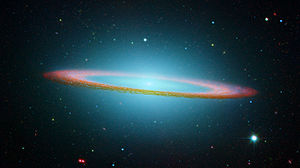
The Sombrero Galaxy (M104) as observed by the Spitzer. Credit: HST/NASA/ESA. Observation data
Epoch J2000Constellation Virgo[3] Right ascension 12h 39m 59.4s[4] Declination -11° 37′ 23″[4] Apparent dimension (V) 8′.7 × 3′.5[4] Apparent magnitude (V) 8.98[4] Characteristics Type SA(s)a;[4] LINER[4] Astrometry Helio Radial velocity 1024 ± 5 [4]km/s Redshift 0.003416 ± 0.000017 [4] Galactocentric Velocity 904 ± 7 [4] km/s Distance 29.3 ± 1.6 Mly (9.0 ± 0.49 Mpc) Other designations Database references SIMBAD Search M104 data See also: Galaxy, List of galaxies The Sombrero Galaxy (also known as M104 or NGC 4594 ) is an unbarred spiral galaxy in the constellation Virgo located 28 million light years from earth. It has a bright nucleus, an unusually large central bulge, and a prominent dust lane in its inclined disk. The dark dust lane and the bulge give this galaxy the appearance of a sombrero. The galaxy has an apparent magnitude of +9.0, making it easily visible with amateur telescopes. The large bulge, the central supermassive black hole, and the dust lane all attract the attention of professional astronomers.
Contents
History
Discovery
The Sombrero Galaxy was discovered in March of 1767 by Pierre Méchain, who described the object in a May 1767 letter to J. Bernoulli that was later published in the Berliner Astronomisches Jahrbuch.[5][6] Charles Messier made a hand-written note about this and five other objects (now collectively recognized as M104 - M109) to his personal list of objects now known as the Messier Catalogue, but it was not "officially" included until 1921.[6] William Herschel independently discovered the object in 1784 and additionally noted the presence of a "dark stratum" in the galaxy's disc, what is now called a dust lane.[5][6] Later astronomers were able to connect Méchain's and Herschel's observations.[6]
Designation as a Messier object
In 1921, Camille Flammarion found Messier's personal list of the Messier objects including the hand-written notes about the Sombrero Galaxy. This was identified with object 4594 in the New General Catalogue, and Flammarion declared that it should be included in the Messier Catalogue. Since this time, the Sombrero Galaxy has been known as M104.[6]
Historical redshift measurements
In the 1910s, Vesto Slipher discovered that the spectra of several galaxies, including the Sombrero Galaxy, are redshifted. The average velocity calculated from these redshifts was 400 km/s. The redshift for the Sombrero Galaxy itself was calculated to be 1100 km/s.[7] Slipher's spectra were among the first observations of the expansion of the universe, one of the key pieces of evidence for the Big Bang Theory.
Slipher also detected rotation within the spectra of the Sombrero Galaxy. His observations of galaxy rotation are among the first ever performed.[7]
 A mid-infrared image of the Sombrero Galaxy as seen by the Spitzer Space Telescope (SST). The white colors represent 3.6 and 5.8 micrometre emission from starlight. The red colors represent 8.0 micrometre emission from polycyclic aromatic hydrocarbons (PAHs) within the dust ring.[8] Credit: Spitzer Infrared Nearby Galaxies Survey/SST/NASA.
A mid-infrared image of the Sombrero Galaxy as seen by the Spitzer Space Telescope (SST). The white colors represent 3.6 and 5.8 micrometre emission from starlight. The red colors represent 8.0 micrometre emission from polycyclic aromatic hydrocarbons (PAHs) within the dust ring.[8] Credit: Spitzer Infrared Nearby Galaxies Survey/SST/NASA.
Dust ring
As noted above, this galaxy's most striking feature is the dust lane that crosses in front of the bulge of the galaxy. This dust lane is actually a symmetric ring that encloses the bulge of the galaxy.[8] Most of the cold atomic hydrogen gas[9] and the dust[8] lies within this ring. The ring might also contain most of the Sombrero Galaxy's cold molecular gas,[8] although this is an inference based on observations with low resolution and weak detections.[10][11] Additional observations are needed to confirm that the Sombrero galaxy's molecular gas is constrained to the ring. Based on infrared spectroscopy, the dust ring is the primary site of star formation within this galaxy.[8]
Nucleus
The nucleus of the Sombrero galaxy is classified as a low ionization nuclear emission region (LINER).[12] These are nuclear regions where ionized gas is present, but the ions are only weakly ionized (i.e. the atoms are missing relatively few electrons). The source of energy for ionizing the gas in LINERs has been debated extensively. Some LINER nuclei may be powered by hot, young stars found in star formation regions, whereas other LINER nuclei may be powered by active galactic nuclei (highly energetic regions that contain supermassive black holes). Infrared spectroscopy observations have demonstrated that the nucleus of the Sombrero Galaxy is probably devoid of any significant star formation activity. However, a supermassive black hole has been identified in the nucleus (as discussed in the subsection below), so this active galactic nucleus is probably the energy source that weakly ionizes the gas in the Sombrero Galaxy.[8]
Central supermassive black hole
In the 1990s, a research group led by John Kormendy demonstrated that a supermassive black hole is present within the Sombrero Galaxy.[13] Using spectroscopy data from both the CFHT and the Hubble Space Telescope, the group showed that the speed of revolution of the stars within the center of the galaxy could not be maintained unless a mass 1 billion times the mass of the Sun, or 109 M☉, is present in the center.[13] This is among the most massive black holes measured in any nearby galaxies.
Synchrotron emission
At radio and X-ray wavelengths, the nucleus is a strong source of synchrotron emission.[14][15][16][17][18][19][20] Synchrotron emission is produced when high velocity electrons oscillate as they pass through regions with strong magnetic fields. This emission is actually quite common for active galactic nuclei. Although radio synchrotron emission may vary over time for some active galactic nuclei, the luminosity of the radio emission from the Sombrero Galaxy only varies 10-20%.[14]
Unidentified submillimeter emission
In 2006, two groups published measurements of the submillimeter radiation from the nucleus of the Sombrero Galaxy at a wavelength of 850 micrometres.[8][20] This submillimeter emission was found not to originate from the thermal emission from dust (which is commonly seen at infrared and submillimeter wavelengths), synchrotron emission (which is commonly seen at radio wavelengths), bremsstrahlung emission from hot gas (which is uncommonly seen at millimeter wavelengths), or molecular gas (which commonly produces submillimeter spectral lines).[8] The source of the submillimeter emission remains unidentified.
Globular clusters
The Sombrero Galaxy has a relatively large number of globular clusters. Observational studies of globular clusters in the Sombrero Galaxy have produced estimates of the population in the range of 1200 to 2000.[21][22][23] The ratio of the number of globular clusters to the total luminosity of the galaxy is high compared to the Milky Way and similar galaxies with small bulges, but the ratio is comparable to other galaxies with large bulges. These results have been repeatedly used to demonstrate that the number of globular clusters in galaxies is thought to be related to the size of the galaxies' bulges. The surface density of the globular clusters generally follows the light profile of the bulge except for near the center of the galaxy.[21][23][24]
Distance
At least two methods have been used to measure the distance to the Sombrero Galaxy.
The first method relies on comparing the measured fluxes from planetary nebulae in the Sombrero Galaxy to the known luminosities of planetary nebulae in the Milky Way. This method gave the distance to the Sombrero Galaxy as 29.0 ± 2.0 Mly (8.9 ± 0.6 Mpc).[1]
The other method used is the surface brightness fluctuations method. This method uses the grainy appearance of the galaxy's bulge to estimate the distance to it. Nearby galaxy bulges will appear very grainy, while more distant bulges will appear smooth. Early measurements using this technique gave distances of 30.6 ± 1.3 Mly (9.4 ± 0.4 Mpc).[25] Later, after some refinement of the technique, a distance of 32 ± 3 Mly (9.8 ± 0.8 Mpc) was measured.[26] This was even further refined in 2003 to be 29.6 ± 2.5 Mly (9.1 ± 0.8 Mpc).[2]
The average distance measured through these two techniques is 29.3 Mly (9.0 Mpc) with an uncertainty of 1.6 Mly (0.5 Mpc).[a]
Nearby galaxies and galaxy group information
The Sombrero Galaxy lies within a complex, filament-like cloud of galaxies that extends to the south of the Virgo Cluster.[27] However, it is unclear as to whether the Sombrero Galaxy is part of a formal galaxy group. Hierarchical methods for identifying groups, which determine group membership by considering whether individual galaxies belong to a larger aggregate of galaxies, typically produce results showing that the Sombrero Galaxy is part of a group that includes NGC 4487, NGC 4504, NGC 4802, UGCA 289, and possibly a few other galaxies.[27][28][29] However, results that rely on the percolation method (i.e. the "friends-of-friends" method), which links individual galaxies together to determine group membership, indicate that either the Sombrero Galaxy is not in a group[30] or that it may only be part of a galaxy pair with UGCA 287.[29]
Amateur astronomy observation information
The Sombrero Galaxy is located 11.5° west of Spica[6] and 5.5° northeast of Eta Corvi.[31] Although the galaxy is visible with 7x35 binoculars or a 4-inch (100 mm) amateur telescope,[31] an 8-inch (200 mm) telescope is needed to distinguish the bulge from the disk,[6] and a 10 or 12-inch (300 mm) telescope is needed to see the dark dust lane.[6]
Other photos

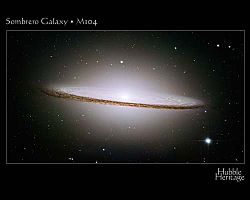
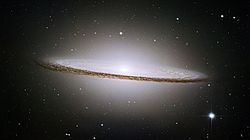
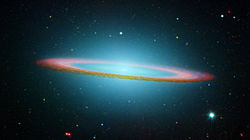
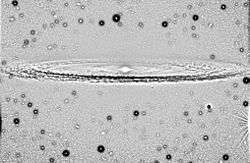
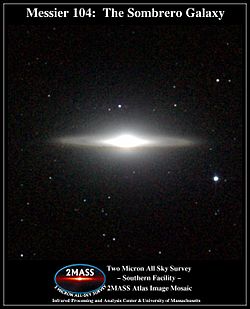
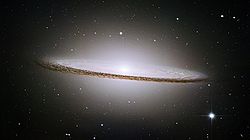

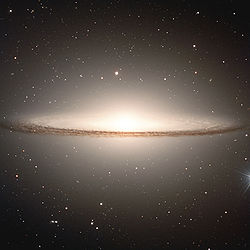
See also
- NGC 1291, a galaxy with an outer dust ring
- NGC 4725, a similar galaxy with an extended dust ring
- NGC 6027a, a member of Seyfert's Sextet with a very similar dust ring structure
- NGC 7742, a spiral galaxy with a similar dust ring
- Ring Galaxies
Notes
- ^ average(29.6 ± 2.5, 29.0 ± 2) = ((29.6 + 29.0) / 2) ± ((2.52 + 2.02)0.5 / 2) = 29.3 ± 1.6
References
- ^ a b H. C. Ford, X. Hui, R. Ciardullo, G. H. Jacoby, K. C. Freeman (1996). "The Stellar Halo of M104. I. A Survey for Planetary Nebulae and the Planetary Nebula Luminosity Function Distance". Astrophysical Journal 458: 455–466. Bibcode 1996ApJ...458..455F. doi:10.1086/176828.
- ^ a b Jensen, Joseph B.; Tonry, John L.; Barris, Brian J.; Thompson, Rodger I.; Liu, Michael C.; Rieke, Marcia J.; Ajhar, Edward A.; Blakeslee, John P. (2003). "Measuring Distances and Probing the Unresolved Stellar Populations of Galaxies Using Infrared Surface Brightness Fluctuations". Astrophysical Journal 583 (2): 712–726. arXiv:astro-ph/0210129. Bibcode 2003ApJ...583..712J. doi:10.1086/345430.
- ^ R. W. Sinnott, ed (1988). The Complete New General Catalogue and Index Catalogue of Nebulae and Star Clusters by J. L. E. Dreyer. Sky Publishing Corporation / Cambridge University Press. ISBN 0-933-34651-4.
- ^ a b c d e f g h i j k l m "NASA/IPAC Extragalactic Database". Results for M104. http://nedwww.ipac.caltech.edu/cgi-bin/nph-objsearch?objname=M104&extend=no&out_csys=Equatorial&out_equinox=J2000.0&obj_sort=RA+or+Longitude&of=pre_text&zv_breaker=30000.0&list_limit=5&img_stamp=YES. Retrieved 2008-07-09.
- ^ a b G. R. Kepple, G. W. Sanner (1998). The Night Sky Observer's Guide. Vol. 2. Willmann-Bell. pp. 451. ISBN 0-943396-60-3.
- ^ a b c d e f g h K. G. Jones (1991). Messier's Nebulae and Star Clusters (2nd ed.). Cambridge University Press. ISBN 0-521-37079-5.
- ^ a b V. M. Slipher (1915). "Spectrographic Observations of Nebulae". Popular Astronomy 23: 21–24. Bibcode 1915PA.....23...21S.
- ^ a b c d e f g h G. J. Bendo, B. A. Buckalew, D. A. Dale, B. T. Draine, R. D. Joseph, R. C. Kennicutt Jr., K. Sheth, J.-D. T. Smith, F. Walter, D. Calzetti, J. M. Cannon, C. W. Engelbracht, K. D. Gordon, G. Helou, D. Hollenbach, E. J. Murphy, H. Roussel (2006). "Spitzer and JCMT Observations of the Active Galactic Nucleus in the Sombrero Galaxy (NGC 4594)". Astrophysical Journal 645 (1): 134–147. arXiv:astro-ph/0603160. Bibcode 2006ApJ...645..134B. doi:10.1086/504033.
- ^ E. Bajaja, G. van der Burg, S. M.; Faber, J. S. Gallagher, G. R. Knapp, W. W. Shane (1984). "The distribution of neutral hydrogen in the Sombrero galaxy, NGC 4594". Astronomy and Astrophysics 141: 309–317. Bibcode 1984A&A...141..309B.
- ^ E. Bajaja, E. Hummel, R. Wielebinski, R.-J. Dettmar (1988). "The large-scale radio continuum structure of the Sombrero galaxy (NGC 4594)". Astronomy and Astrophysics 202: 35–40. Bibcode 1988A&A...202...35B.
- ^ J. S. Young, S. Xie, L. Tacconi, P. Knezek, P. Viscuso, L. Tacconi-Garman, N. Scoville, S. Schneider, F. P. Schloerb, S. Lord, A. Lesser, J. Kenney, Y.-L. Huang, N. Devereux, M. Claussen, J. Case, J. Carpenter, M. Berry, L. Allen (1995). "The FCRAO Extragalactic CO Survey. I. The Data". Astrophysical Journal Supplement 98: 219–257. Bibcode 1995ApJS...98..219Y. doi:10.1086/192159.
- ^ L. C. Ho, A. V. Filippenko, W. L. W. Sargent (1997). "A Search for "Dwarf" Seyfert Nuclei. III. Spectroscopic Parameters and Properties of the Host Galaxies". Astrophysical Journal Supplement 112 (2): 315–390. arXiv:astro-ph/9704107. Bibcode 1997ApJS..112..315H. doi:10.1086/313041.
- ^ a b J. Kormendy, R. Bender, E. A. Ajhar, A. Dressler, S. M. Faber, K. Gebhardt, C. Grillmair, T. R. Lauer, D. Richstone, S. Tremaine (1996). "Hubble Space Telescope Spectroscopic Evidence for a 1 X 10 9 M☉ Black Hole in NGC 4594". Astrophysical Journal Letters 473 (2): L91–L94. Bibcode 1996ApJ...473L..91K. doi:10.1086/310399.
- ^ a b A. G. de Bruyn, P. C. Crane, R. M. Price, J. B. Carlson (1976). "The radio sources in the nuclei of NGC 3031 and NGC 4594". Astronomy and Astrophysics 46: 243–251. Bibcode 1976A&A....46..243D.
- ^ E. Hummel, J. M. van der Hulst, J. M. Dickey (1984). "Central radio sources in spiral galaxies - Starburst or accretion". Astronomy and Astrophysics 134: 207–221. Bibcode 1984A&A...134..207H.
- ^ A. Thean, A. Pedlar, M. J. Kukula, S. A. Baum, C. P. O'Dea (2000). "High-resolution radio observations of Seyfert galaxies in the extended 12-μm sample - I. The observations". Monthly Notices of the Royal Astronomical Society 314 (3): 573–588. arXiv:astro-ph/0001459. Bibcode 2000MNRAS.314..573T. doi:10.1046/j.1365-8711.2000.03401.x.
- ^ T. Di Matteo, C. L. Carilli, A. C. Fabian (2001). "Limits on the Accretion Rates onto Massive Black Holes in Nearby Galaxies". Astrophysical Journal 547 (2): 731–739. arXiv:astro-ph/0005516. Bibcode 2001ApJ...547..731D. doi:10.1086/318405.
- ^ S. Pellegrini, G. Fabbiano, F. Fiore, G. Trinchieri, A. Antonelli (2002). "Nuclear and global X-ray properties of LINER galaxies: Chandra and BeppoSAX results for Sombrero and NGC 4736". Astronomy and Astrophysics 383 (1): 1–13. arXiv:astro-ph/0111353. Bibcode 2002A&A...383....1P. doi:10.1051/0004-6361:20011482.
- ^ S. Pellegrini, A. Baldi, G. Fabbiano, D.-W. Kim (2003). "An XMM-Newton and Chandra Investigation of the Nuclear Accretion in the Sombrero Galaxy (NGC 4594)". Astrophysical Journal 597 (1): 175–185. arXiv:astro-ph/0307142. Bibcode 2003ApJ...597..175P. doi:10.1086/378235.
- ^ a b M. Krause, R. Wielebinski, M. Dumke (2006). "Radio polarization and sub-millimeter observations of the Sombrero galaxy (NGC 4594). Large-scale magnetic field configuration and dust emission". Astronomy and Astrophysics 448 (1): 133–142. arXiv:astro-ph/0510796. Bibcode 2006A&A...448..133K. doi:10.1051/0004-6361:20053789.
- ^ a b K.-I. Wakamatsu (1977). "Radial distribution and total number of globular clusters in M104". Publications of the Astronomical Society of the Pacific 89: 267–270. Bibcode 1977PASP...89..267W. doi:10.1086/130114.
- ^ W. E. Harris, H. C. Harris, G. L. H. Harris (1984). "Globular clusters in galaxies beyond the local group. III NGC 4594 (the Sombrero)". Astronomical Journal 89: 216–223. Bibcode 1984AJ.....89..216H. doi:10.1086/113504.
- ^ a b T. J. Bridges, D. A. Hanes (1992). "The globular cluster system of NGC 4594 (the Sombrero)". Astronomical Journal 103: 800–814. Bibcode 1992AJ....103..800B. doi:10.1086/116102.
- ^ S. S. Larsen, D. A. Forbes, J. P. Brodie (2001). "Hubble Space Telescope photometry of globular clusters in the Sombrero galaxy". Monthly Notices of the Royal Astronomical Society 327 (4): 1116–1126. arXiv:astro-ph/0107082. Bibcode 2001MNRAS.327.1116L. doi:10.1046/j.1365-8711.2001.04797.x.
- ^ E. A. Ajhar, T. R. Lauer, J. L. Tonry, J. P. Blakeslee, A. Dressler, J. A. Holtzman, M. Postman (1997). "Calibration of the Surface Brightness Fluctution Method for use with the Hubble Space Telescope". Astronomical Journal 114: 626–634. Bibcode 1997AJ....114..626A. doi:10.1086/118498.
- ^ J. L. Tonry, A. Dressler, J. P. Blakeslee, E. A. Ajhar, A. B. Fletcher, G. A. Luppino, M. R. Metzger, C. B. Moore (2001). "The SBF Survey of Galaxy Distances. IV. SBF Magnitudes, Colors, and Distances". Astrophysical Journal 546 (2): 681–693. arXiv:astro-ph/0011223. Bibcode 2001ApJ...546..681T. doi:10.1086/318301.
- ^ a b R. B. Tully (1988). Nearby Galaxies Catalog. Cambridge University Press. ISBN 0-521-35299-1.
- ^ P. Fouque, E. Gourgoulhon, P. Chamaraux, G. Paturel (1992). "Groups of galaxies within 80 Mpc. II - The catalogue of groups and group members". Astronomy and Astrophysics Supplement 93: 211–233. Bibcode 1992A&AS...93..211F.
- ^ a b G. Giuricin, C. Marinoni, L. Ceriani, A. Pisani (2000). "Nearby Optical Galaxies: Selection of the Sample and Identification of Groups". Astrophysical Journal 543 (1): 178–194. arXiv:astro-ph/0001140. Bibcode 2000ApJ...543..178G. doi:10.1086/317070.
- ^ A. Garcia (1993). "General study of group membership. II - Determination of nearby groups". Astronomy and Astrophysics Supplement 100: 47–90. Bibcode 1993A&AS..100...47G.
- ^ a b S. J. O'Meara (1998). The Messier Objects. Cambridge University Press. ISBN 0-521-55332-6.
External links
- Hubble Mosaic of the Majestic Sombrero Galaxy (ESA)
- HubbleSite: The Majestic Sombrero Galaxy (M104)
- M104, the Sombrero Galaxy (NightSkyInfo.com)
- Messier 104 (SEDS)
- Sombrero Galaxy:A Great Observatories View
- M104 The Sombrero Galaxy
- The Sombrero Galaxy on WikiSky: DSS2, SDSS, GALEX, IRAS, Hydrogen α, X-Ray, Astrophoto, Sky Map, Articles and images
Messier objects List M1 · M2 · M3 · M4 · M5 · M6 · M7 · M8 · M9 · M10 · M11 · M12 · M13 · M14 · M15 · M16 · M17 · M18 · M19 · M20 · M21 · M22 · M23 · M24 · M25 · M26 · M27 · M28 · M29 · M30 · M31 · M32 · M33 · M34 · M35 · M36 · M37 · M38 · M39 · M40 · M41 · M42 · M43 · M44 · M45 · M46 · M47 · M48 · M49 · M50 · M51 · M52 · M53 · M54 · M55 · M56 · M57 · M58 · M59 · M60 · M61 · M62 · M63 · M64 · M65 · M66 · M67 · M68 · M69 · M70 · M71 · M72 · M73 · M74 · M75 · M76 · M77 · M78 · M79 · M80 · M81 · M82 · M83 · M84 · M85 · M86 · M87 · M88 · M89 · M90 · M91 · M92 · M93 · M94 · M95 · M96 · M97 · M98 · M99 · M100 · M101 · M102 · M103 · M104 · M105 · M106 · M107 · M108 · M109 · M110See also  Book:Messier objects ·
Book:Messier objects ·  Category:Messier objects
Category:Messier objects  Portal:AstronomyCategories:
Portal:AstronomyCategories:- Spiral galaxies
- Unbarred spiral galaxies
- LINER galaxies
- Virgo constellation
- Messier objects
- NGC objects
- PGC objects
Wikimedia Foundation. 2010.

